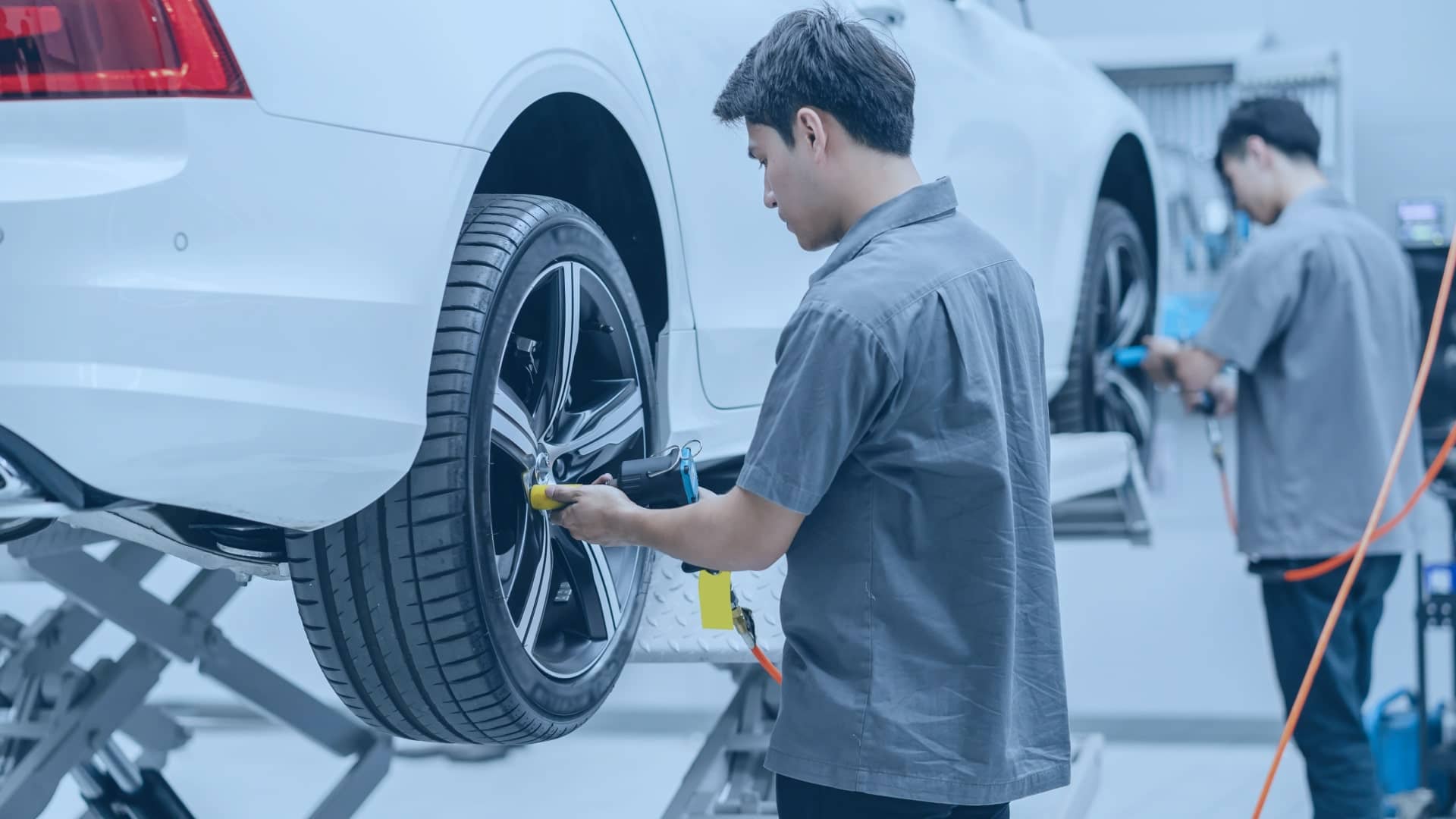In the dynamic and ever-evolving world of fleet management, staying ahead of the curve is crucial. One of the key areas that demand attention is tire maintenance. This blog delves into the importance of a Tire Maintenance System for fleets, highlighting how it’s not just a trend but a necessity in today’s fast-paced transport and logistics industry.
What is Tire Maintenance System?
A Tire Maintenance System (TMS) is a technological feature found in vehicles that is designed to monitor the condition and performance of the tires in real time. This system helps ensure that the tires are maintained in optimal condition, which can enhance vehicle safety, improve fuel efficiency, and extend tire life. There are several components and functions commonly associated with a Tire Maintenance System, including:
- Tire Pressure Monitoring System (TPMS): This is perhaps the most well-known part of the TMS. TPMS monitors the air pressure of . It alerts the driver when tirethe tires pressure is significantly under- or over-inflated, which can lead to reduced vehicle performance, increased tire wear, or even tire failure.
- Tread Depth Monitoring: Some advanced TMS implementations can also monitor the depth of the tire tread. It ensures that tires are replaced before they become dangerously worn. Adequate tread depth is crucial for maintaining good traction on the road, especially in adverse weather conditions.
- Temperature Monitoring: Tire temperature can be an important indicator of the tire’s condition. Excessive heat can indicate overloading, excessive speed, or under-inflation, all of which can accelerate tire wear or lead to tire failure.
- Tire Rotation Reminders: Proper tire rotation at regular intervals helps ensure even tire wear, extending the life of the tires. Some TMS implementations might include reminders or recommendations for when to rotate the tires based on mileage or time.
- Diagnostic Tools: Advanced systems may also include diagnostic tools to identify potential issues with tires or related components, helping drivers to take preventative measures before minor issues become major problems.
By providing real-time data and alerts related to tire health, a Tire Maintenance System helps drivers maintain their tires more effectively, contributing to safer driving conditions, better vehicle performance, and cost savings over the long term. Adoption of such systems varies by manufacturer, vehicle model, and market, with some systems offering more advanced features than others.
The Imperative of Tire Maintenance in Fleet Management
Prolonging Tire Life and Reducing Costs
Tire maintenance is pivotal for prolonging tire life and reducing operational costs. Tires represent a significant investment for fleet operators. Regular maintenance ensures that tires are in optimal condition, thereby extending their lifespan and reducing the need for frequent replacements.
Enhancing Safety
Safety is paramount in fleet operations. Well-maintained tires reduce the risk of accidents caused by tire failures. A Tire Maintenance System actively monitors tire health, alerting managers to potential issues before they lead to hazardous situations.
Improving Fuel Efficiency
The condition of tires directly impacts fuel efficiency. Properly inflated and well-maintained tires ensure that vehicles consume fuel more efficiently, lowering the overall fuel costs for the fleet.
Trends in Tire Maintenance Systems
With technology advancing, tire maintenance systems are becoming more sophisticated. The latest systems offer real-time monitoring and analytics, providing fleet managers with invaluable insights into tire performance and maintenance needs.
Real-Time Monitoring
Modern Tire Maintenance Systems use sensors to monitor tire pressure and temperature in real-time. This continuous monitoring allows for immediate detection of issues, enabling prompt responses to prevent tire-related incidents.
Predictive Maintenance
These systems are increasingly leveraging predictive analytics. By analyzing historical data, they can predict potential tire issues, allowing for proactive maintenance and reducing downtime.
Our Tire Monitoring Feature: A Game-Changer
Our Tire Monitoring Feature stands out in the market. It offers comprehensive tire health insights, helping fleet managers make informed decisions about maintenance.
Continuous Health Monitoring
Our system continuously monitors tire condition, ensuring that any deviation from the norm is quickly identified and addressed.
Customizable Alerts
Fleet managers receive customizable alerts, allowing them to prioritize maintenance tasks based on real-time data.
Detailed Reporting
The system provides detailed reports, offering a clear picture of tire health across the entire fleet. This data is crucial for planning maintenance schedules and budgeting for tire replacements.
The Importance of Ease of Use
While the technology behind Tire Maintenance Systems is complex, ease of use is key. Our system is designed with user-friendliness in mind, ensuring that fleet managers can easily access and interpret tire health data.
User-Friendly Interface
The interface of our system is intuitive, allowing users to quickly navigate and find the information they need.
Simplified Data Presentation
Data is presented in a simplified, easy-to-understand format, making it accessible even to those without technical expertise.
The Benefits of Tire Maintenance: Ensuring Safety and Efficiency in Transportation
Proper tire maintenance is a critical aspect of vehicle management, yet it’s often overlooked. Whether for personal vehicles, commercial trucks, or entire fleet operations, the benefits of regular tire maintenance are numerous and impactful. This article will explore the various advantages of maintaining tires, emphasizing their importance in safety, cost savings, and overall vehicle performance.
Enhanced Safety
Safety is the most significant benefit of regular tire maintenance. Well-maintained tires are crucial for:
- Improved Traction: Adequate tread depth is vital for proper grip on road surfaces, especially in adverse weather conditions. Regular tire inspections ensure that tread wear is even and within safe limits.
- Reduced Risk of Blowouts: Proper inflation and timely inspections can prevent tire blowouts, which are not only dangerous but can also lead to serious accidents.
- Better Handling: Tires in good condition offer improved handling and stability, essential for safe driving.
Cost Savings
Regular tire maintenance can lead to substantial cost savings:
- Extended Tire Life: Regular rotation and balancing, along with maintaining proper tire pressure, can significantly extend a tire’s lifespan, reducing the frequency of replacements.
- Improved Fuel Efficiency: Properly inflated tires reduce rolling resistance, which means the vehicle consumes less fuel, leading to cost savings and environmental benefits.
- Avoidance of Costly Repairs: By identifying and addressing minor issues early through regular checks, more significant and expensive problems can be avoided.
Improved Performance
The condition of tires directly affects vehicle performance:
- Optimal Comfort: Well-maintained tires contribute to a smoother ride by reducing vibrations and noise.
- Enhanced Vehicle Response: Good tire condition ensures better response to steering, braking, and acceleration inputs.
- Stable Load Carrying: Especially important for commercial vehicles, properly maintained tires ensure the safe and stable carrying of loads.
Environmental Benefits
Tire maintenance also offers environmental advantages:
- Reduced Emissions: Proper tire inflation leads to lower fuel consumption, which, in turn, results in lower greenhouse gas emissions.
- Decreased Tire Waste: Extending the life of tires means fewer tires are discarded, reducing environmental waste.
Importance in Fleet Management
For fleet operators, tire maintenance is even more crucial:
- Uptime Maximization: Regular maintenance reduces the likelihood of tire-related breakdowns, ensuring that vehicles remain operational and schedules are maintained.
- Fleet Safety Compliance: Keeping tires in optimal condition is essential for meeting safety regulations and standards in the transportation industry.
- Asset Management: By maintaining tires properly, the overall value and longevity of the fleet vehicles are preserved.
The Interplay of Tire Selection and Maintenance
Choosing the right tires sets the stage for fleet efficiency and safety. It involves understanding the specific needs of the fleet, considering factors like vehicle type, usage, road conditions, and climate. The right tires, tailored to these factors, can significantly enhance vehicle performance and safety.
Maintenance: Sustaining Performance and Safety
Once the appropriate tires are selected, regular maintenance becomes crucial. This includes routine inspections, proper inflation, timely rotation, and alignment checks. Regular maintenance ensures that the tires, carefully chosen for specific needs, continue to deliver optimal performance and safety.
Why This Integration Matters
Maximizing Tire Lifespan and Performance
Proper maintenance extends the life of the tires, ensuring that the fleet gets the most out of the initial investment. Well-maintained tires also maintain their performance characteristics, such as traction and fuel efficiency, over their lifespan.
Safety is Paramount
The combination of the right tires and regular maintenance significantly reduces the risk of tire-related accidents. Properly maintained tires ensure reliable performance in various driving conditions, safeguarding both the driver and the vehicle.
Cost-Effectiveness
Choosing the right tires and maintaining them well is cost-effective. It reduces the need for frequent tire replacements and prevents costly downtime caused by tire failures. Additionally, well-maintained tires contribute to better fuel efficiency, further reducing operational costs.
Compliance and Reputation
For commercial fleets, adhering to safety standards and regulations is non-negotiable. Proper tire selection and maintenance are often part of these regulatory requirements. Meeting these standards not only avoids penalties but also enhances the fleet’s reputation for safety and reliability.
Key Takeaways for Fleet Managers
Invest in Quality Tires
Choose tires that align with your fleet’s specific requirements. This investment lays the groundwork for safety and efficiency.
Implement a Rigorous Maintenance Program
Regular tire inspections and maintenance should be integral to your fleet management strategy. This includes checking tire pressure, tread depth, and overall tire condition regularly.
Train Your Team
Ensure that your drivers and maintenance personnel are well-trained in tire maintenance best practices. Their awareness and proactive approach can make a significant difference.
Monitor and Evaluate
Use tire monitoring systems and regular evaluations to assess the effectiveness of your tire selection and maintenance strategy. This will help in making informed decisions for future improvements.
Conclusion
In summary, regular tire maintenance is an essential practice for vehicle owners and fleet managers alike. It ensures safety, reduces costs, enhances performance, and contributes to environmental sustainability. By prioritizing tire maintenance, one can enjoy a safer, more efficient, and cost-effective driving experience.
Remember, well-maintained tires are the foundation of a successful, safe, and efficient fleet. Embrace the technology and stay ahead in the game.



